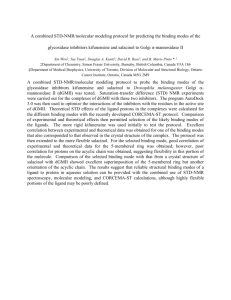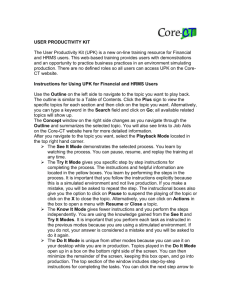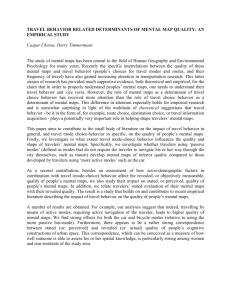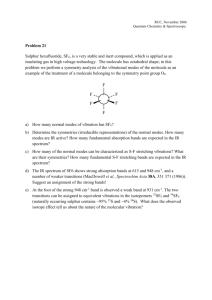Normal Mode Analysis
advertisement
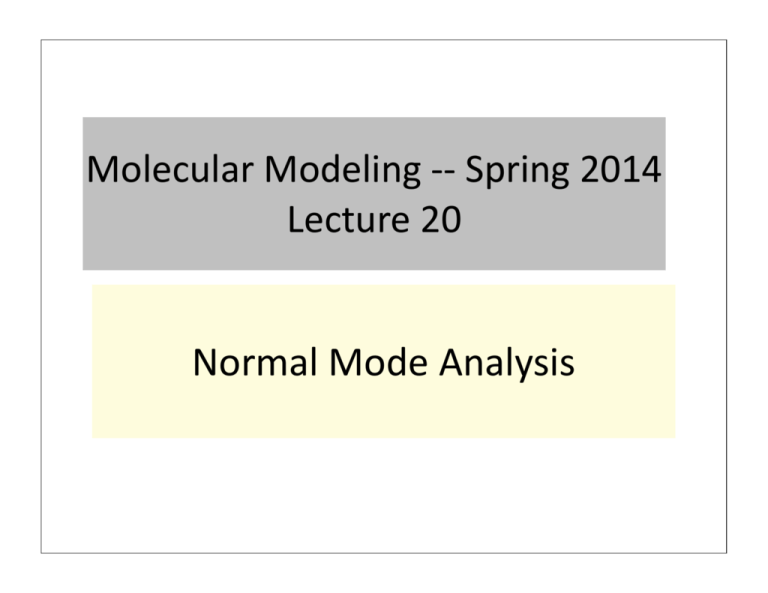
Molecular Modeling -­‐-­‐ Spring 2014 Lecture 20 Normal Mode Analysis 1.Normal modes 2.Solving for Normal Modes 3.Enzyme catalysis and ligand-­‐induced conformaBonal changes 4.Exercise 21 The knowledge of protein flexibility is then crucial for understanding protein function and evolution. Manuel Rueda, Pablo Chaco ́and Modesto Orozco 3 20.1 Normal modes 4 20.1 Normal modes • modes = harmonic (sinusoidal) moBons. • normal = independent of each other. A normal mode is a motion where all parts of the system are moving sinusoidally with the same frequency and in phase. All observed configurations of a system may be generated from its normal modes. Each normal mode has a characteristic frequency, its eigenvalue. 5 Normal modes The Tacoma Narrows bridge, opened in 1940, had a normal mode that resonated with a 40 mph wind, until it broke. 6 Simple harmonic moBon E 0 0 y=1/2 x2 Imagine a Hooke’s Law spring, or a parabolic energy function. The magnitude of a restoring force is proportional to displacement. Solving the differential equation gives a harmonic equation for x at time t, x t 7 Normal modes for coupled oscillators 0 x1 0 x2 If we denote acceleration (the second derivative of x(t) with respect to time) as , the equations of motion are: We assume oscillatory motion, so: Substituting these into the equations of motion gives us: http://en.wikipedia.org/wiki/Normal_mode 8 Since the exponential factor is common to all terms, we omit it and simplify: And in matrix representation: For this equation to have a non-trivial solution, the matrix on the left must be singular i.e. must not be invertible, such that one cannot multiply both sides of the equation by the inverse, leaving the right matrix equal to zero. It follows that the determinant of the matrix must be equal to 0, so: http://en.wikipedia.org/wiki/Normal_mode 9 We have two solutions: If we substitute ω1 into the matrix and solve for (A1, A2), we get (1, 1). If we substitute ω2, we get (1, −1). (These vectors are eigenvectors, and the frequencies ω are eigenvalues.) The first normal mode is: (1, 1) ω1, low frequency mode Which corresponds to both masses moving in the same direction at the same time. The second normal mode is: (1, −1) ω2, high frequency mode 10 This corresponds to the masses moving in the opposite directions, while the center of mass remains stationary. http://en.wikipedia.org/wiki/Normal_mode CharacterisBcs of normal mode moBon • Each normal mode acts like a simple harmonic oscillator. • A normal mode is concerted moBon of many atoms. • Center of the mass doesn’t move. • All atom pass through their equilibrium posiBons at the same Bme. • Normal modes are orthogonal to each other; they resonate independently. • Directly related to vibraBonal spectroscopy. Symmetric stretch Asymmetric stretch Bending Infrared spectrum of air Normal modes resonate with light at the frequency of oscillation. Stretching modes of the protein backbone Secondary structure defines the steric and H-bonding interactions, which change the energy of the bond. Steric clashes stretch bonds. H-bonds polarize and weaken the covalent bond. Amide I Secondary Structure and Amide I frequency 20.2 Solving for Normal modes 17 Normal modes for a network of springs m m m m Normal mode analysis assumes that all pairwise forces behave like Hooke’s Law springs for short displacements. In other words, all “atoms” (or points on a drum, or on a bridge, or...) are sitting in a “harmonic well”, a parabola. All points move is synchrony, in phase. 18 Normal modes are eigenvectors of the Hessian matrix. • NM are fluctuations around the ground state. • NM atom motions are approximated as straight lines. • Anywhere on that line, the sum of all forces on an atom drives it to another point on the same line. • Force in one dimension may be expressed as the second derivative of the energy times the displacement in that direction. • Forces in multiple directions i may be expressed as the sum of the second partial derivatives for all pairs of interactions (i,j), times the displacement in direction j. 19 Hessian matrix If there were only two atoms, the force vector on the first atom x1 would be F1 = ∇1E = ∂E = ∂x1 ∂2E ∆x1 ∂x1 ∂x1 + ∂2E ∆x2 ∂x1 ∂x2 http://en.wikipedia.org/wiki/Hessian_matrix 20 Hessian matrix Two atom case, both atoms F1 = ∇1E = ∂E = ∂x1 ∂2E ∆x1 ∂x1 ∂x1 F2 = ∇2E = ∂E = ∂x2 ∂2E ∆x2 ∂x2 ∂x2 Note, ∂ 2E ∂x1 ∂x2 = + ∂2E ∆x2 ∂x1 ∂x2 + ∂2E ∆x1 ∂x2 ∂x1 ∂ 2E ∂x2 ∂x1 In matrix notation, ∂ 2E ∂x1 ∂x1 ∂ 2E ∂x2 ∂x1 ∂ 2E ∂x2 ∂x1 ∂ 2E ∂x2 ∂x2 F1 ∆x1 = ∆x2 F2 http://en.wikipedia.org/wiki/Hessian_matrix 21 Hessian matrix Many atom case ∂ 2E ∂x1 ∂x1 ∂ 2E ∂x2 ∂x1 ∂ 2E ∂x2 ∂x1 ∂ 2E ∂x2 ∂x2 • • • ∂ 2E ∂xn ∂x1 H ∂ 2E ∂xn ∂x1 ••• • • • ∂ 2E ∂xn ∂xn F1 ∆x1 xF ∆x2 • • • ∆xn = = F2 • • • Fn So the force vectors F as a function of the vector of displacement vectors x is F= H·x 22 Normal modes are eigenvectors of the Hessian matrix. H·x = F Normal modes are the special case where the forces line up with the displacements. In other words, H·x = λx where λ is a scaler. This means x is an eigenvector by definition. To solve for x, first we combine terms. (H-λI)·x = 0 where I is the identity matrix. Since we are looking for non-trivial solutions, the matrix (HλI) cannot be invertible, therefore it must be singular, therefore the determinant is zero. 23 Solving the eigenvector problem det(H-λI) = 0 Offered without proof: There are n solutions to the equation above, where n is the rank of H. Each solution has a vector x and a scaler value λ. λ is the eigenvalue associate with each eigenvector x. eigenvector x consists of a displacement of each atom in each direction (x,y,z). Each H·xi =λixi, i=1,...,3N where N = number of atoms. 24 Numerical second derivaBves A closed form for the second derivative is usually not available, so they are calculated numerically. The gradient of the energy with respect to i is evaluated after displacement of atom j in each direction (x,y,z). The difference between the gradients divided by the displacement in j is the second derivative. The difference between the slopes is (approx.) the 2nd deriv. 25 ProperBes of eigenvalues The product of the eigenvalues is equal to the determinant of A The sum of the eigenvalues is equal to the trace of A Eigenvectors are real, and mutually orthogonal Eigenvectors provide a basis for 26 General procedure for normal mode analysis in a protein • Energy minimizaBon • Calculate Hessian • Divide by mass matrix (to get acceleraBons, because F=ma) • “Diagonalize”, solve for eigenvectors. – Eigenvalues: high eigenvalue mean low force constant, low frequency. • Low frequencies are important for proteins – Eigenvectors: direcBons of movement: visualize Successive approximaBon method • Since for all normal modes x, H·x = λx : – Randomly iniBalize a vector of displacements y – MulBply y by H to get y’ – Rescale y’ – MulBply y’ by H to get y’’ – Rescale y’’ – Etc. Stop when it converges. The result is the first normal mode x. – Project matrix H onto vector x, reducing rank of H by 1. – Repeat process to get normal mode 2. • Here is a tool being developed by a PhD student Osman Burak Okan, RPI Materials Engineering. http://midst.sabanciuniv.edu/anm/ • Other NMA tools: – webnm – elNemo http://apps.cbu.uib.no/webnma hdp://www.igs.cnrs-­‐mrs.fr/elnemo/start.html 29 Principle Components Analysis (PCA) • Similar to NMA, but the Hessian matrix is replaced by a covariance matrix. • Covariances are calculated from superimposed coordinates from a MD simulaBon. • PCA compresses and summarizes MD. 39 20.3 Enzyme catalysis and conformaBonal changes 41 A story of how conformational changes in an enzyme contribute to enzyme catalysis. E=dihydrofolate reductase=DHFR Watch the DHFR movie http://chem-faculty.ucsd.edu/kraut/dhfr.html Bystroff C & Kraut J. (1991). Crystal structure of unliganded Escherichia coli dihydrofolate reductase. Ligand-induced conformational changes and cooperativity in binding. Biochemistry 30, 2227-39. Crystal structures were solved for DHFR in 3 liganded states, and unliganded (apo). The difference distance matrix shows two domains. The N and C terminal segments of the chain move together relative to the middle domain (the domain that binds the adenosine moiety of NADPH). The shift is caused by MTX binding. 43 Superposed backbone traces for five bound states of DHFR, showing domain rotaBon. 1. Apo, 2. Holo (NADP bound), 3. Ternary (folate and NADP bound), 4.-5. methotraxate (tight-binding inhibitor, 2 structures) 44 Approximate axes of the domain rotations (*) binding of NADP to apoenzyme, (#) binding of methotrexate to apoenzyme (molecule 2) (@) 45 binding of methotrexate to apoenzyme (molecule 1) Methotrexate (MTX) binds to DHFR with the pterin group flipped upside down, causing the tail group to shift relative to folate. MTX binds much more tightly than folate (or DHF). The +-end of two alpha helices make H-bonds to the pyophosphate group of NADPH. Lining up the H-bonds is only possible if the C-helix shifts relative to the F-helix. Making H-bonds “pays for” the conformational change. 47 FuncBonal significance of conformaBonal change DHFR adds a hydrogen to C6 making it a sp3 carbon and changing the angle of the “tail” para-aminobenzoate group, with the pterin. Binding a tail with a sharper angle favors the product (THF) over the substrate (DHF). 48 Induced fit • Thermodynamically, a conformaBonal change following binding and a conformaBonal change preceding binding are the same, energeBcally. But one route may be faster than the other. • The route starBng with binding, followed by conformaBonal change, may be called “induced fit”. • The route starBng with conformaBonal change, followed by binding, may be called “selected fit”. selected fit Enz’ + S ⇌ Enz’•S ⇌ ⇌ ⇌ induced fit Enz + S Enz•S 50 Do exercise 20 • Normal mode analysis of DHFR • 4dfr, 5dfr, 6dfr or 7dfr 51
